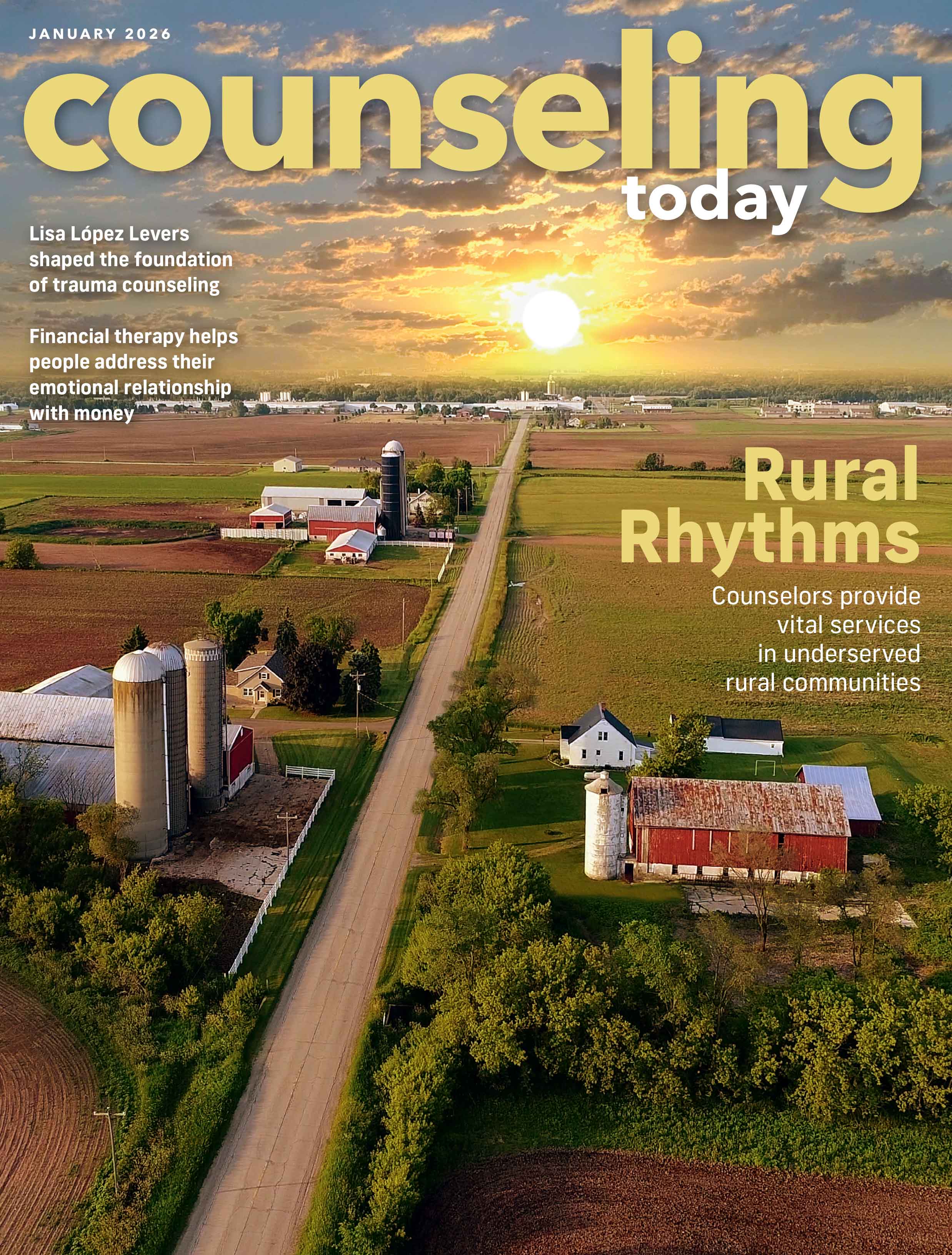The Myths (and Truths) of Human Trafficking
By Samantha Cooper, Staff Writer
July 2025

A suspicious-looking stranger in the Target parking lot. A white windowless van. A woman locked in a basement. These are the images people might describe when they hear the phrase “human trafficking.” But these are largely myths; the reality is far more sinister.
Most victims know their traffickers. In many cases, they were groomed beforehand, manipulated into trusting the person who would later profit from their body and labor.
Most traffickers build trust over a period of time until the last thing victims expect is to get into a commercial sex act or some form of forced labor, according to Brandi Bynum, unit chief for outreach and engagement at the Department of Homeland Security Center for Countering Human Trafficking.
Victims aren’t just girls or young women, but men and boys, as well. They can be forced into all kinds of work, from sex to labor. Trafficking doesn’t happen only in developing foreign nations, either, Bynum says. Human trafficking can happen anywhere, including in your own neighborhood.
After all, human trafficking is a $150 billion industry that victimizes more than 20 million people each year. It is often intertwined with gun and drug trafficking or major criminal activities such as money laundering.
“There are so many different things that are tied into human trafficking. People are less aware of that. They don’t see everything that’s going on behind it,” says Lourdes Araujo, EdD, LMHC, immediate past president of the Florida Counseling Association, who also discussed the topic in the May issue of Counseling Today.
The myths and misconceptions the public has surrounding human trafficking are harmful because they prevent the people being trafficked from being recognized as victims and getting the help they need.
The Truth About Human Trafficking
Victims of human trafficking are typically vulnerable — they may be runaways, homeless, addicted to drugs or otherwise unable to access basic necessities on their own, Araujo explains.
Traffickers will spend time observing their targets before making contact and slowly gaining their trust. They will pretend to empathize with the victim and offer exactly what that person needs at that moment of their lives. Eventually, Araujo explains, there will be a bond, and the victim will often believe there is no way they are being exploited. They are simply helping a friend or loved one.
The abuser can be anyone: a friend, romantic partner or even a family member, and the abuse can take place in the victim’s home. Parents may traffic their own children to pay rent or fund their drug habit, Bynum explains. But because the public perception is that strangers are doing the trafficking, this idea is often hard for people to accept.
“It’s a rude awakening. Could you imagine your family trafficking and making money off of you? For a trafficker, it’s a business, and it’s a real sick business,” Araujo says.
What Is Labor Trafficking?
There is also a prevalent myth that the only type of human trafficking is for the sex trade — but forced labor trafficking is also a huge industry.
The victims of forced labor trafficking aren’t always undocumented immigrants, though they often are. People often pay to be smuggled into another country, in the hopes of a better life, Bynum explains. Often, the smuggler will force the victim into work to pay off an imposed debt. This situation can be difficult to escape.
When people are trafficked for labor, they are often lured by the promise of a well-paying job and a better life. But when they arrive at their new workplace, traffickers seize their documents and assets, leaving them with no option but to work for little to no money, Bynum says. If they try to leave, the traffickers may threaten them or their families to force the victims to stay.
Major online “fast fashion” retailers like Shein have been in the news recently for allegedly forcing their factory employees to work in exploitative conditions to keep prices low for consumers.
“You don’t see who is being exploited from behind your computer screen when you put in an order; they’re working like slaves. If you’re getting something from these companies, the person who is making it is likely being trafficked,” Araujo says.
Such companies aren’t the only ones linked to having forced labor in their supply chain; Nestlé, Nike, Apple and Amazon have all been documented to have used forced and likely trafficked labor in the production of their products, according to sources such as the Occupational Safety and Health Administration and the Tech Transparency Project. Large international companies aren’t the only ones that use forced labor. The agricultural and hospitality industries use forced labor, as well. Labor trafficking can happen in businesses of any size — including your favorite local restaurant or nail salon.
The smaller the company, the harder it may be to figure out if the company is using trafficked labor — unless you know what to look for.
Identifying a Human Trafficking Victim
Victims of human trafficking, be it sexual or forced labor, may show physical, psychological and behavioral traits such as the following:
- Malnourishment or signs of neglect
- Excessive fatigue
- A lack of awareness about basic facts like their age. If they’re traveling, they may not know their destination.
- Unexplained injuries in various stages of healing
- Rehearsed responses when talking
- Inappropriate clothing for the weather
- Constant hypervigilance, as though somebody is looking over their shoulder
- Lack of control over their property such as ID and money
- Not being allowed to speak for themselves and being accompanied by another person at all times
These signs aren’t necessarily a guarantee somebody is being trafficked, but everyone should watch out for them. If you aren’t sure, Bynum says, always go with your gut feeling.
“A gut check is important. If something doesn’t feel right, it may not be right,” she adds.
If you identify a victim of human trafficking, you can contact the following organizations:
- National Human Trafficking Hotline: 888-373-7888
- National Center for Missing & Exploited Children: 800-843-5678
- American Medical Association: 312-464-4782
These organizations are trained in how to properly help victims because supporting them is a complex and delicate process. According to Bynum, it typically takes around seven attempts to convince a victim to leave their abuser, and often the outside world isn’t so gentle.
“People are so ingrained into the lives of their traffickers that they have nowhere else to go. We need to give them a lot of grace,” she says.
Resources for Raising Awareness
The best chance for victims to get help often lies with health care workers. Research shows around 87% of trafficking survivors’ primary contacts, outside of their abuser, are with some kind of healthcare professional. Often, the abuser will bring the victim to a health care professional to treat an unwanted pregnancy, sexually transmitted disease or other medical issue.
However, during such health care visits, victims are rarely identified. This indicates more training needs to be done, Araujo adds. In the meantime, Araujo and Bynum have both worked with other organizations to stop human trafficking.
Araujo works closely with Truckers Against Trafficking, a coalition made up of over 1.5 million professional truck drivers who are trained to spot victims of human trafficking at truck stops.
Bynum recently worked with several organizations to raise awareness of the signs of human trafficking in New Orleans, before the 2025 Super Bowl. The Super Bowl and other major sporting events often present ideal environments for sexual exploitation. To combat this, Bynum’s organization held the Blue Campaign Anti-Human Trafficking Resource and Learning Expo. The expo was open to the public but was geared toward professionals who work with youth and hotel hospitality professionals. The event included a training session for hospitality workers and a session focused on talking to young people about human trafficking. In addition, Bynum will replicate the event in Mexico in September, ahead of the FIFA World Cup.
The idea behind such events is to educate people on what human trafficking looks like and how human traffickers operate. “After all,” she says, “How can you stop human trafficking if you don’t know what it looks like?”
Get Involved: World Day Against Trafficking in Persons
World Day Against Trafficking in Persons takes place on July 30. The United Nations (U.N.) declared this year’s theme as “Human Trafficking is Organized Crime — End the Exploitation.” The theme will focus on how organized crime networks profit from human trafficking and the importance of law enforcement in the fight against them.
In addition, the U.N.’s Blue Heart Campaign raises awareness around the globe of human trafficking and its impact on people and society. The campaign features a blue heart, which represents solidarity with human trafficking victims and the cold-heartedness of human traffickers. The U.N. is encouraging people to post and share the blue heart symbol on social media with the hashtag #EndHumanTrafficking.
Search CT Articles
Current Issue
Sign Up for Updates
Keep up to date on the latest in counseling practice. Sign up to receive email updates from Counseling Today.


